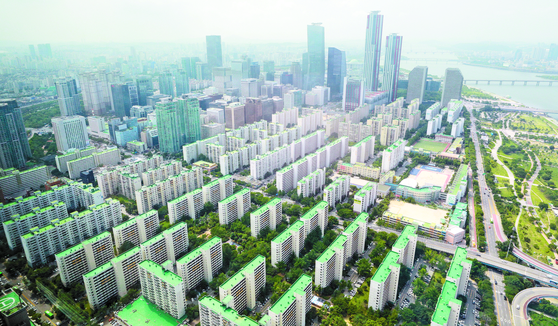
An apartment in downtown Seoul viewed from the 63 Square Observation Deck, Yeongdeungpo-gu, Seoul. News 1
Rep. Kang Dae-ho of the Seoul Metropolitan Council (Democratic Party) owned 25 houses, ranking’multi-housing’ among high-ranking public officials in the Republic of Korea. Four high-ranking officials owned more than 10 houses. The proportion of multi-homed people (26.3% → 15.5%) among high-ranking public officials decreased significantly compared to last year, which is interpreted as a result of the government’s strong recommendation to dispose of housing for multi-homed people.
This is the result of the JoongAng Ilbo’s investigation into the status of all the property reports of high-ranking public officials on the 24th. According to the Public Officials Ethics Act, government offices such as the President and high-ranking public officials with a level 1 (or’A’ level) or higher disclose their property every year, and this target is 1885. (Excluding the National Assembly and the Court)
Disposal of 5 multi-household houses that had 25 houses

Top 8. High-ranking multi-homed people Graphic = Kim Hyun-seo [email protected]
Seoul City Councilman Dae-ho Kang, who owned 25 houses, was the number one multi-household for high-ranking officials with 30 houses last year. Kang, who owned 13 multi-family houses in Jungnang-gu, Seoul, built 17 small houses with an exclusive area of less than 10 pyeong in Gapyeong, Gyeonggi-do in 2019. Among them, five Gapyeong row houses under the joint name of the couple were sold last year.
Seoul Metropolitan Government Assemblyman Lee Jeong-in (the Democratic Party), who was second in the number of high-ranking houses last year (24), also sold two multi-family houses in Songpa-gu, Seoul, and has 22 houses. Most of the lawmakers and Mrs. Lee have small apartments in the metropolitan area of around 12 to 21 pyeong, which are in great demand for charter. Lee is registered as a rental business and manages housing assets.
Five of the top eight high-ranking officials with a large number of homeowners were also members of the Democratic Party. Kim Joon-seong, who is third in the number of houses with 14 houses following Rep. Kang Dae-ho (1st place) and Lee Jung-in (2nd place), won the election in 2018 as a member of the Democratic Party. 9 members of the Seoul Metropolitan Government Heum-jae Seong and 8 members of the Gyeonggi Province member Hwang Jin-hee also belong to the Democratic Party.
High-ranking multi-homed people 496 → 293 people
Last year, 496 (26.3%) of the 1889 high-ranking government officials of the Blue House, the administrative and local governments were multi-homed, but this year it has decreased significantly to 293 (15.5%). The government issued a strong recommendation to dispose of housing for multi-homed public officials, and as the criticism increased, the number of public officials disposing of their owned houses increased. In particular, public officials who had apartments in the metropolitan area and Sejong City generally chose to dispose of apartments in Sejong City.

Increase and decrease of multi-homed people in high-ranking government departments. Graphic = Kim Hyun-seo [email protected]
In the case of the Ministry of Land, Infrastructure and Transport, which is in charge of real estate policy, 1st Vice Minister Yoon Seong-won and 2nd Vice Minister Son Myung-soo, who were second-home residents last year, sold an apartment in Sejong City instead of an apartment in Gangnam, Seoul. The Ministry of Land, Infrastructure and Transport last year had 8 multi-homed persons out of 33 public officials who reported property reports, but this year there was no one. Cheong Wa Dae’s industrial policy secretary Yoo Jeong-yeol, Eun Seong-soo, chairman of the Financial Services Commission, Park Jin-gyu, vice minister of the Ministry of Trade, Industry and Energy, and Kim Gyeong-seon, vice minister of the Ministry of Gender Equality and Family, were also found to have disposed of apartments in Sejong City, leaving one apartment in the metropolitan area.
Among the Ministers and Vice Ministers of the Administration, only Minister of Maritime Affairs and Fisheries Moon Sung-hyuk was a two-homed. Minister Moon has joint apartments with his spouse in Malmö, Sweden, and Suyeong-gu, Busan, where he previously worked (World Maritime University).
To avoid the stigma of multi-homed people… ‘Gift’ and’Inter-family transaction’
As the government’s pressure on multi-homed people intensified, there were cases of donating homes or transferring ownership to families. Yongin Mayor Baek Gun-gi, who reported that he owned 14 houses last year, donated 13 row houses located in Hannam-dong, Yongsan-gu, Seoul, and became one house owner (apartment in Bangbae-dong, Seocho-gu). Mayor Baek was elected as a candidate for the Democratic Party’s Yongin Mayor in 2018. Sejong Mayor Lee Chun-hee also donated an apartment to his son in Gwacheon, Gyeonggi-do last year.
Choi Gi-ju, chairman of the Metropolitan Transportation Committee of the Ministry of Land, Infrastructure and Transport, sold an apartment in Suwon-si, Gyeonggi-do for 178 million won last year, becoming one house, but there is a case where Choi’s mother reported that he purchased an apartment with the same address at the same price.
Reporter Kim Won [email protected]
The number of houses was counted like this
‘Number of houses’ refers to’the number of apartments, single houses, multi-family houses, multi-family houses, row houses, and apartment sales rights owned by the person and spouse’. Officetels, neighborhood living facilities, and shopping centers that are not classified as houses by law were not included in the number of houses. The residential-commercial complex was excluded from this count because it was not possible to know whether it was a house or a shopping mall only with the address that was written in the property disclosure.
![]()
